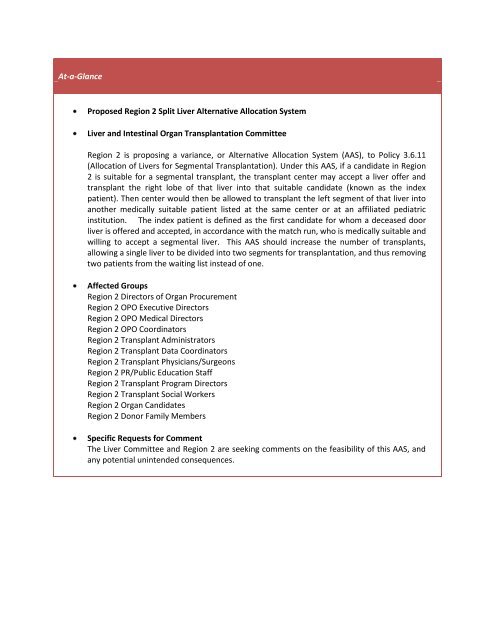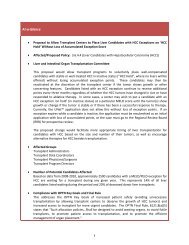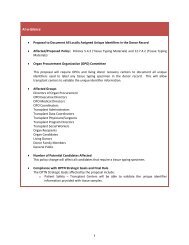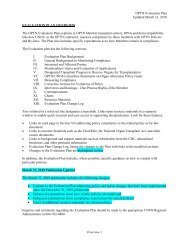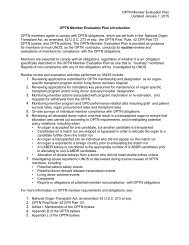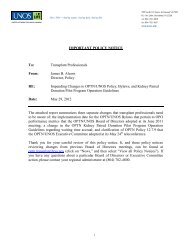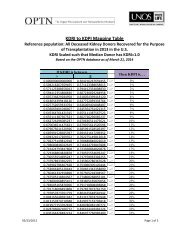Proposal - Organ Procurement and Transplantation Network - HRSA
Proposal - Organ Procurement and Transplantation Network - HRSA
Proposal - Organ Procurement and Transplantation Network - HRSA
You also want an ePaper? Increase the reach of your titles
YUMPU automatically turns print PDFs into web optimized ePapers that Google loves.
At-a-GlanceProposed Region 2 Split Liver Alternative Allocation SystemLiver <strong>and</strong> Intestinal <strong>Organ</strong> <strong>Transplantation</strong> CommitteeRegion 2 is proposing a variance, or Alternative Allocation System (AAS), to Policy 3.6.11(Allocation of Livers for Segmental <strong>Transplantation</strong>). Under this AAS, if a c<strong>and</strong>idate in Region2 is suitable for a segmental transplant, the transplant center may accept a liver offer <strong>and</strong>transplant the right lobe of that liver into that suitable c<strong>and</strong>idate (known as the indexpatient). Then center would then be allowed to transplant the left segment of that liver intoanother medically suitable patient listed at the same center or at an affiliated pediatricinstitution. The index patient is defined as the first c<strong>and</strong>idate for whom a deceased doorliver is offered <strong>and</strong> accepted, in accordance with the match run, who is medically suitable <strong>and</strong>willing to accept a segmental liver. This AAS should increase the number of transplants,allowing a single liver to be divided into two segments for transplantation, <strong>and</strong> thus removingtwo patients from the waiting list instead of one.Affected GroupsRegion 2 Directors of <strong>Organ</strong> <strong>Procurement</strong>Region 2 OPO Executive DirectorsRegion 2 OPO Medical DirectorsRegion 2 OPO CoordinatorsRegion 2 Transplant AdministratorsRegion 2 Transplant Data CoordinatorsRegion 2 Transplant Physicians/SurgeonsRegion 2 PR/Public Education StaffRegion 2 Transplant Program DirectorsRegion 2 Transplant Social WorkersRegion 2 <strong>Organ</strong> C<strong>and</strong>idatesRegion 2 Donor Family MembersSpecific Requests for CommentThe Liver Committee <strong>and</strong> Region 2 are seeking comments on the feasibility of this AAS, <strong>and</strong>any potential unintended consequences.
Proposed Region 2 Split Liver Alternative Allocation SystemLiver <strong>and</strong> Intestinal <strong>Organ</strong> <strong>Transplantation</strong> CommitteeSummary <strong>and</strong> Goals of the <strong>Proposal</strong>:Region 2 is proposing a variance, or alternative allocation system (AAS) to Policy 3.6.11 (Allocation ofLivers for Segmental <strong>Transplantation</strong>). Under this AAS, if a c<strong>and</strong>idate in Region 2 is suitable for asegmental transplant, the transplant center may accept a liver offer <strong>and</strong> transplant the right lobe of thatliver into that suitable c<strong>and</strong>idate (known as the index patient). Then center would then be allowed totransplant the left segment of that liver into another medically suitable patient listed at the same centeror at an affiliated pediatric institution. The index patient is defined as the first c<strong>and</strong>idate for whom adeceased door liver is offered <strong>and</strong> accepted, in accordance with the match run, who is medically suitable<strong>and</strong> willing to accept a segmental liver. This AAS should increase the number of transplants, allowing asingle liver to be divided into two segments for transplantation, <strong>and</strong> thus removing two patients fromthe waiting list instead of one. The AAS will hopefully reduce waiting times for liver c<strong>and</strong>idates overall,because the liver pool would be exp<strong>and</strong>ed by splitting livers that otherwise would not be split.Background <strong>and</strong> Significance of the <strong>Proposal</strong>:Small children with end-stage liver disease suffer the most from the extreme shortage of deceaseddonor organs due to the difficulty of finding size-matched donors. The allocation of organs from smallpediatric donors to multiorgan recipients has recently made the problem even worse for small pediatricc<strong>and</strong>idates who do not have the option of a living donor transplant. Two of the largest-volume pediatricintestine transplant programs reside within the region, as do multiple pediatric liver transplantprograms, which means pediatric c<strong>and</strong>idates in this region may suffer disproportionately.Split-liver transplantation (SLT), a procedure where one deceased donor liver is divided to provide fortwo recipients, would immediately exp<strong>and</strong> the existing deceased donor pool. This is done by dividingappropriate donor livers in such a way that a surgeon can transplant the left lateral liver graft into asmall child <strong>and</strong> then transplant the right extended liver graft into a medically suitable adult or teenager.Since its introduction in 1988, improved donor <strong>and</strong> recipient selection for SLT have increased the donorpool <strong>and</strong> decreased pediatric pretransplant mortality. To date, the principal beneficiaries of SLT havebeen adult/pediatric recipient pairs with excellent outcomes reported. This innovative technique did notharm the adult recipient pool 1 .While the results of SLT are comparable to whole organ transplantation, surgeons rarely employ thistechnique for a variety of reasons. Significant obstacles to the widespread application of SLT exist <strong>and</strong>the transplant community must resolve these obstacles before greater utilization can be realized 2 . Themajor obstacle is the experience <strong>and</strong> skill of the surgeon. Although splitting a liver maximizes thenumber of patients receiving an organ transplant, it may increase the morbidity <strong>and</strong> mortality for theindividual patient who receives the split liver.1 Kim JS, Broering DC, Tustas RY, Fischer L, Ganschow R, Burdelski M, Rogiers X.Split liver transplantation: past,present <strong>and</strong> future. Pediatr Transplant. 2004 Dec;8(6):644-8.2 Renz JF, Yersiz H, Reichert PR, Hisatake GM, Farmer DG, Emond JC, Busuttil RW. Split-liver transplantation: areview.Am J Transplant. 2003 Nov;3(11):1323-35.
Because split liver transplantation is so technically challenging, <strong>and</strong> because they are responsible for thelives of their transplant patients, surgeons typically wish to perform the surgery themselves. However,the current OPTN/UNOS allocation requires that a split liver must be offered sequentially down thecombined OPO-wide liver match run, rather than just to the center that performs the split. This policytherefore poses another major obstacle to splitting. When the match run sequence requires that theleft lobe or left lateral segment must be offered to another center, surgeons will often ab<strong>and</strong>on thesplit. Transplant centers often do not see the benefit of increasing the risk of morbidity for the right loberecipient, when the remaining liver segment is sent to another center. Thus, the current incentive, bothin terms of workload <strong>and</strong> potential outcome for the patient, is for the surgeon to accept the entire liverfor a single patient when the offer is made.Region 2 wants to increase liver availability <strong>and</strong> ensure the best outcome in graft survival. They hope todo this by allowing the surgeon to split appropriate livers, transplanting the right lobe in the indexpatient at their center, <strong>and</strong> using the left lateral segment (that the surgeon is already familiar with sincehe/she split the graft) in another medically suitable c<strong>and</strong>idate at the same center (or affiliated pediatriccenter).The Region 2 programs estimate that no more than 10 percent of its liver donors might be used forthese types of splits because the variance does not affect the current sharing system of whole livertransplants when needed <strong>and</strong> appropriate. Nationally, it is estimated that split liver transplantationtechnique including the pediatric splits, although attractive, will apply to less than 25 % of the donors. 3Advantages of the Proposed AASSLT was developed because of organ scarcity <strong>and</strong> an increased number of deaths on the waiting list. Thegap between organ supply <strong>and</strong> recipient dem<strong>and</strong> has never been greater. This has renewed interest inincreasing the application of traditional adult/pediatric SLT <strong>and</strong> performance of adult/adult SLT. 2This AAS will allow for more transplants since to a single liver will be divided into two segments fortransplantation; removing two patients from the waiting list instead of one. Without the AAS, thesegrafts would likely be transplanted into a single adult as a whole organ transplant.Process for AAS ApprovalPolicy 3.4.8.1 (Application) states that “Applications to allocate organs using alternative pointassignment systems or to distribute organs using sharing arrangements or ALUs are submitted to theappropriate organ-specific committees for consideration before being issued for public commentaccording to processes for public comment. Such applications are then reconsidered by the relevantCommittee in light of public comment. Final applications to allocate organs locally using alternativepoint assignments or to distribute organs using sharing arrangements or ALUs must be presented to <strong>and</strong>approved by the Board of Directors before they can be implemented or used in organallocation/distribution.“ 4In November 2009, the Liver <strong>and</strong> Intestinal <strong>Organ</strong> <strong>Transplantation</strong> Committee approved circulating thisAAS for public comment, citing the Final Rule’s requirement that allocation policies “shall seek to3 Liver transplantation in adults. Dur<strong>and</strong> F, Belghiti J. Med Sci (Paris). 2005 Jan;21(1):89-94.4 http://optn.transplant.hrsa.gov/Policies<strong>and</strong>Bylaws2/policies/pdfs/policy_8.pdf
achieve the best use of donated organs.” 5 During a subsequent call in February 2010, Committeemembers raised several concerns about the potential lack of transparency in the acceptance process,<strong>and</strong> suggested that the AAS review should include information about which c<strong>and</strong>idates are bypassed inthe split liver allocation. Others were concerned about the degree of informed consent required for ac<strong>and</strong>idate to underst<strong>and</strong> that he/she is being offered a whole liver, but is being asked to accept onlypart of the liver in order to benefit another patient (i.e., a child) on the list. Committee members feltthat the index patient should receive the liver even if the final decision is to keep the whole liver.Ultimately, the Committee still agreed that the proposal should be circulated for public comment, withthese concerns noted. The Policy Oversight Committee also reviewed the AAS proposal <strong>and</strong> approved itsdistribution for public comment.Policy 3.4.8.1 also states that “In cases where unanimity cannot be achieved at the local level,applications to allocate organs using either an alternative point assignment system, sharing agreementor ALU must have approval of 75% of the Member OPOs <strong>and</strong> or transplant centers.“ In this case, 18 of23 of the potential participants (78%) are in agreement with the AAS.Supporting Evidence <strong>and</strong>/or Modeling:Research shows that outcomes for recipients of split liver grafts for pediatric/adult splits are similar tothat of whole liver transplantation. 6 Adult/adult SLT is showing promising results as well. Individualcenter data on adult/adult SLT are summarized in the table below. The Paul Brousse group has reportedthe largest series on adult/adult SLT 7 . In 1996, Bismuth reported 1- year patient <strong>and</strong> graft survival of79% <strong>and</strong> 78%, respectively, on 27 SLT grafts, with the routine application of ex vivo SLT increasing overallgraft availability at their center by 28%. 8 A later series comparing 1- <strong>and</strong> 2-year SLT patient <strong>and</strong> graftsurvival to adults receiving deceased donor whole-organ transplantation over the same time perioddemonstrated right- <strong>and</strong> left-SLT graft 1-year recipient survival of 74% <strong>and</strong> 88% respectively, with 1-yeargraft survival of 74% for right-SLT vs. 75% for left-SLT recipients.Expected Impact on Program Goals, Strategic Plan, <strong>and</strong> Adherence to OPTN Final Rule:This AAS is intended to achieve the best use of donated organs, achieve equitable organ allocation, <strong>and</strong>maximize the number of donors <strong>and</strong> transplants. The AAS will increase the donor pool by encouraging atransplant center that receives a liver offer to split the liver <strong>and</strong> use it in two adult recipients or an adult<strong>and</strong> a child, rather than using the entire organ in one recipient.5 42 CFR Part 121, see http://optn.transplant.hrsa.gov/policiesAndBylaws/final_rule.asp6 Azoulay D, Astarcioglu I, Bismuth H et al. Split-liver transplantation. The Paul Brousse policy. Ann Surg 1996; 224: 737-746;discussion 746-748.7 Azoulay D, Marin-Hargreaves G, Castaing D, Bismuth H. Ex situ splitting of the liver: the versatile Paul Brousse technique. ArchSurg 2001; 136: 956-961.8 Azoulay D, Castaing D, Adam R et al. Split-liver transplantation for two adult recipients: feasibility <strong>and</strong> long-term outcomes. AnnSurg 2001; 233: 565-574.
Table 1Adult/Adult Split-Liver <strong>Transplantation</strong> 2Center Author Year N Recipient Graft CompSurvival SurvivalUlsan 9 Hwang 2004 2 100% 100% N/AMinneapolis 10 Humar 2001 18 89% 89% 43%Villejuif 5 Azoulay 2001 34 81% 75% 24%Minneapolis 11 Humar 2001 12 83% 83% 58%Hamburg 12 Broering 2001 12 93% 85% N/AGenoa 13 Andorno 2001 10 100% 80% N/ABergamo 14 Colledan 2000 8 87% 63% 75%Eppendorf 15 Gundiach 2000 4 100% 100% N/AVillejuif 4 Azoulay 1996 27 79% 78% 37%Comp = overall complication rateN/A = data not reportedExpected Impact on organ allocation <strong>and</strong> waiting times for transplant c<strong>and</strong>idates waiting timesThe potential impact is not known, but the AAS is not expected to make a difference in waiting times forany specific blood type. Overall, all waiting times would be expected to decrease if more people aretransplanted. Region 2 liver programs will reassess the program after 12 months in order to see ifwaiting times of any particular blood group were adversely affected.Expected Impact on organ allocation <strong>and</strong> waiting times among the various categories of medicalurgencyThe AAS will potentially reduce waiting times for patients overall because the liver pool would beexp<strong>and</strong>ed by splitting livers that otherwise would not be split.Expected Impact on organ allocation <strong>and</strong> waiting times for transplant c<strong>and</strong>idates who are pediatric,female or represent racial minorities9 Hwang S, Lee SG, Park KM, Kim KH, Ahn CS, Moon DB, Ha TY. A case report of split liver transplantation for two adult recipients inKorea. Division of Hepatopancreatobiliary Surgery <strong>and</strong> Liver <strong>Transplantation</strong>, Department of Surgery, Asan Medical Center, UlsanUniversity College of Medicine, Seoul 138-736, Korea. Transplant Proc. 2004 Nov;36(9):2736-40.10 Humar A, K<strong>and</strong>aswarmy R, Sielaff T, Gruessner RW, Knaak M, Lake JR. Split-liver transplants for 2 adult recipients: an initialexperience, American Transplant Congress, Transplant 2001, Chicago, IL, May 12-16, 2001.11 Humar A, Ramcharan T, Sielaff T et al. Split liver transplantation for two adult recipients: an initial experience. Am J Transplant2001; 1: 366-372.12 Broering D, Gundlach M, Topp S, Mueller L, Rogiers X, In-situ full-right-full left splitting: the ultimate expansion of the adultdonor pool, Transplant 2001, Chicago, IL. May 12-16, 2001.13 Andorno E, Genzone A, Morelli N et al. On liver for two adults: in-situ split liver transplantation for two adult recipients.Transplant Proc 2001; 33: 1420-1422.14 Colledan M, Broering D, Topp S, Sterneck M, Rogiers X. Split-cava technique: liver splitting for two adult recipients. Liver Transpl2000; 6: 703-706.15 Gundlach M, Broering D, Topp S, Sterneck M, Rogiers X. Split-cava technique: liver splitting for two adult recipients. LiverTranspl 2000;6: 703-706.
The AAS should not adversely affect any transplant c<strong>and</strong>idates who are pediatric, female or representracial minorities. The proposal will likely increase access for pediatric c<strong>and</strong>idates <strong>and</strong> decrease theirwaiting times.Plan for Evaluating the <strong>Proposal</strong>:The Region will review the results after the first 10 splits. The cases will be reviewed at the nextst<strong>and</strong>ing Region 2 meeting once the AAS is approved. However, if the retransplant rate exceeds 5 of the20 grafts before the regional meeting, an automatic hold will be placed on the procedure until theresults <strong>and</strong> surgical practices can be reviewed.Additional Data Collection:This proposal does not require additional data collection.Expected Implementation Plan:This proposal will not require programming in UNet SM .Communication <strong>and</strong> Education Plan:If approved, this AAS will be communicated to the liver transplant programs <strong>and</strong> OPOs in Region 2through the consolidated policy notice that is distributed after each Board meeting.Monitoring <strong>and</strong> Evaluation:The Department of Evaluation <strong>and</strong> Quality Allocation (DEQ) Analysis staff will monitor each allocation toensure the available liver was allocated according to approved AAS guidelines. If a member institutiondoesn’t follow the outlined guidelines of the AAS, the DEQ may ask them to clarify allocation details. IfDEQ staff identify a potential violation of OPTN/UNOS policies or bylaws, they will forward all relatedinformation to the Membership <strong>and</strong> Professional St<strong>and</strong>ards Committee for review <strong>and</strong> due process.<strong>Proposal</strong>:If a transplant center in Region 2 accepts a liver for a c<strong>and</strong>idate that is suitable for a segmentaltransplantation, the center shall be allowed to transplant a lobe into that institution’s index patient <strong>and</strong>the other lobe into any other medically suitable listed patient at that institution or an affiliated pediatricinstitution. This AAS will only apply when the index patient will receive the right lobe of the liver. If theindex patient is to receive the left lateral segment of the liver, then the right lobe of the liver will beallocated as per policy 3.6.11(i)in sequence, as determined by the deceased donor liver allocation algorithm set forth in Policy3.6 (Allocation of Livers) <strong>and</strong> defining “local” based upon the Host OPO’s local area, to thehighest-ranking c<strong>and</strong>idate on the waiting list of c<strong>and</strong>idates; provided, however, that the HostOPO places the liver segment(s) by the time the donor organ procurement procedure hasstarted, or
(ii)into c<strong>and</strong>idates listed with the recipient program or any medically appropriate c<strong>and</strong>idate on theWaiting List, if, after reasonable attempts by the Host OPO to place the remaining portion(s) ofthe donor liver, the liver segment(s) is not placed by the time the donor organ procurementprocedure has started.


